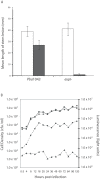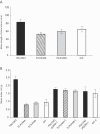Quorum sensing coordinates brute force and stealth modes of infection in the plant pathogen Pectobacterium atrosepticum
- PMID: 18566662
- PMCID: PMC2413422
- DOI: 10.1371/journal.ppat.1000093
Quorum sensing coordinates brute force and stealth modes of infection in the plant pathogen Pectobacterium atrosepticum
Abstract
Quorum sensing (QS) in vitro controls production of plant cell wall degrading enzymes (PCWDEs) and other virulence factors in the soft rotting enterobacterial plant pathogen Pectobacterium atrosepticum (Pba). Here, we demonstrate the genome-wide regulatory role of QS in vivo during the Pba-potato interaction, using a Pba-specific microarray. We show that 26% of the Pba genome exhibited differential transcription in a QS (expI-) mutant, compared to the wild-type, suggesting that QS may make a greater contribution to pathogenesis than previously thought. We identify novel components of the QS regulon, including the Type I and II secretion systems, which are involved in the secretion of PCWDEs; a novel Type VI secretion system (T6SS) and its predicted substrates Hcp and VgrG; more than 70 known or putative regulators, some of which have been demonstrated to control pathogenesis and, remarkably, the Type III secretion system and associated effector proteins, and coronafacoyl-amide conjugates, both of which play roles in the manipulation of plant defences. We show that the T6SS and a novel potential regulator, VirS, are required for full virulence in Pba, and propose a model placing QS at the apex of a regulatory hierarchy controlling the later stages of disease progression in Pba. Our findings indicate that QS is a master regulator of phytopathogenesis, controlling multiple other regulators that, in turn, co-ordinately regulate genes associated with manipulation of host defences in concert with the destructive arsenal of PCWDEs that manifest the soft rot disease phenotype.
Conflict of interest statement
The authors have declared that no competing interests exist.
Figures





References
-
- Whitehead NA, Barnard AM, Slater H, Simpson NJ, Salmond GP. Quorum-sensing in Gram-negative bacteria. FEMS Microbiol Rev. 2001;25:365–404. - PubMed
-
- Gardan L, Gouy C, Christen R, Samson R. Elevation of three subspecies of Pectobacterium carotovorum to species level: Pectobacterium atrosepticum sp. nov., Pectobacterium betavasculorum sp. nov. and Pectobacterium wasabiae sp. nov. Int J Syst Evol Microbiol. 2003;53:381–391. - PubMed
-
- Toth IK, Bell KS, Holeva MC, Birch PRJ. Soft rot erwiniae: from genes to genomes. Molecular Plant Pathology. 2003;4:17–30. - PubMed
-
- Holeva MC, Bell KS, Hyman LJ, Avrova AO, Whisson SC, et al. Use of a pooled transposon mutation grid to demonstrate roles in disease development for Erwinia carotovora subsp. atroseptica putative type III secreted effector (DspE/A) and helper (HrpN) proteins. Mol Plant Microbe Interact. 2004;17:943–950. - PubMed
Publication types
MeSH terms
Grants and funding
LinkOut - more resources
Full Text Sources
Miscellaneous

